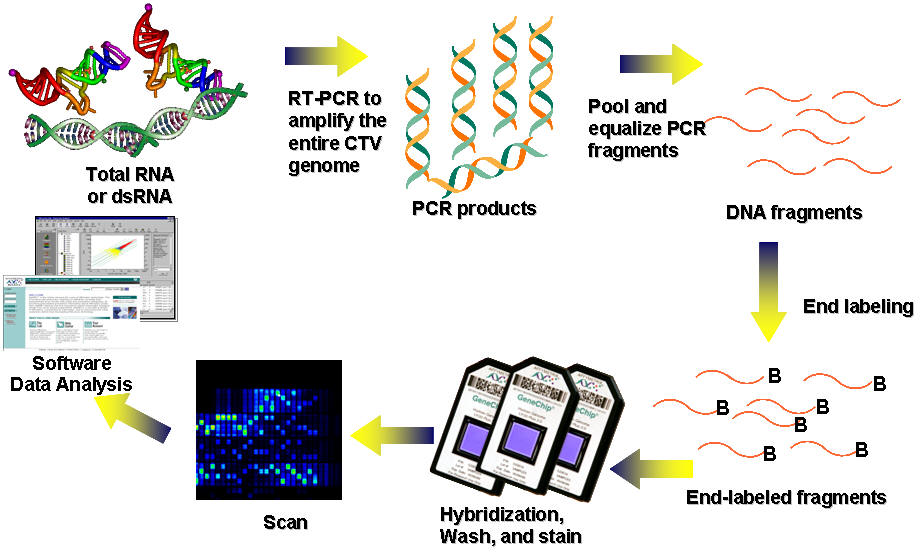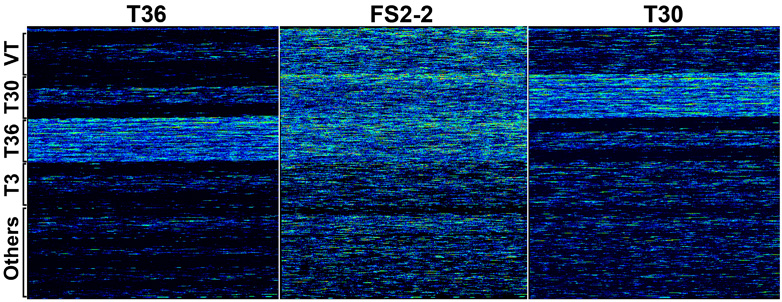
Fig. 1. Electron micrograph of a single, complete Citrus tristeza virus particle. Sap from infected a citrus leaf was spread directly on the EM grid. The virus particle was negatively stained with uranyl acetate (Z. Xiong).
Citrus tristeza virus (CTV) is a member of the genus Closterovirus within the family Closteroviridae. It is the most important and destructive virus of citrus. CTV virions (Fig. 1) are flexuous rods, 2000 nm in length and 12 nm in diameter, consisting of one single-stranded, (+)-sense RNA genome encapsidated by two species of coat proteins (97% CP and 3% CPm).
 Fig. 1. Electron micrograph of a single, complete Citrus tristeza virus particle. Sap from infected a citrus leaf was spread directly on the EM grid. The virus particle was negatively stained with uranyl acetate (Z. Xiong). |
The 19.2 to 19.3 kb CTV genome, one of the largest in RNA viruses, contains 12 open reading frames. The 5’ half of the genome is translated directly to a large, frameshifting protein that contains motifs characteristic of RNA-dependent RNA polymerase, helicase, methyltransferase, and proteases. This protein is required for CTV replication and is most likely proteolytically cleaved into smaller, functional proteins. The 3’ half encodes ten proteins expressed from ten 3’ co-terminal subgenomic RNAs. These proteins include viral structural proteins and proteins interacting with host plants.
CTV is perhaps one of the most diverse viruses with numerous, disparate strains, each inducing different types and degrees of disease symptoms on different citrus species and varieties. In nature, CTV often exists as a complex, comprising multiple strains or genotypes due to the longevity of citrus trees and their vegetative propagation by budwood. Continual vertical transmission coupled to repeated horizontal transmission mediated by aphids throughout the history of citrus cultivation has led to the complexity of the CTV population increasing over hundreds of years, resulting in the co-existence of multiple CTV genotypes in a single host. The presence within a host of multiple replicating CTV genotypes and the relatively long periods of co-replication create opportunities for recombination between the genotypes, leading to extensive viral diversity.

Fig. 1. Simplified work flow of resequencing analysis of Citrus tristeza virus.
Full genomic sequences of representative CTV isolates were selected for microarray tiling because of the tiling capacity of the microarray (Table 1). The selection was based on the phylogenetic analysis of fully sequenced CTV genomes available at the time of the microarray design. Genomes of the remaining CTV isolates were then compared to that of the tiled and the most closely related CTV genome to identify unique sequences of the genomes for additional microarray tiling. The complete tiling comprises four full-length CTV genomes, one partial genome, and unique sequences from other CTV isolates, representing a genetic diversity equivalent to that contained in ten complete CTV genomes.
Table 1. CTV sequences tiled on the resequencing microarray
|
CTV strains/isolates
|
No. of Bases
|
|
T30
|
19,259
|
|
T36
|
19,293
|
|
VT
|
19,226
|
|
T3
|
19,253
|
|
T68-1
|
13,585
|
|
SY568 unique
sequence
(5’ VT + 3’ T30)
|
8,090
|
|
H33 unique sequence (VT)
|
8,391
|
|
NUagA unique sequence (VT)
|
9,991
|
|
T385 unique sequence (T30)
|
127
|
|
Qaha unique sequence (T36)
|
2,298
|
|
Total nucleotides
|
117,088
|
|
Internal control nucleotides
|
807
|
|
Total Probes
|
943,160
|
CTV genomic DNA required for resequencing analysis was obtained by long-range reverse transcription-polymerase chain reaction (RT-PCR), using four sets of universal primers (Table 2). Each set of primers consisted of an RT primer and a pair of PCR primers, and were designed using sequences highly conserved in all known CTV genomes. Together, the four sets of primers were capable of amplifying entire genomes of all known CTV isolates as four DNA fragments ranging from 4.5 to 5.5 kb (Fig. 2).


Fig. 2. DNA fragments representing entire CTV genomes amplified by RT-PCR from FS2-2. 1-3, DNA amplified by the 3’ primer CTV5427R and three 5’ primers: CTV5endFT36, CTV5endFVT, and FT30CTV5end, respectively; 4, DNA amplified by primers CTV5403F and CTV09997R; 5, DNA amplified by primers CTV09262F and CTV14630R; and 6, DNA amplified by primers CTV14469F and CTV19395R. kb, 1 kb DNA ladder.

Fig. 3. Images of hybridized resequence microarrays. Affymetrix CTV Microarray chips were hybridized with target DNA from T36 and T30 strains and an unknown sample, FS2-2. Warm colors and cool colors represent higher and lower hybridization intensities, respectively. Locations of tiled CTV genomes on the microarray are indicated to the left. Single genome blocks are hybridized with T36 and T30 target DNA while multiple genome blocks are hybridized with FS2-2 target DNA .
To rapidly sequence a large number of CTV genomes, study the CTV complex at the sequence level, we designed and validated an Affymetrix resequencing microarray that queries entire genomes of multiple CTV genotypes [28]. Sequences tiled on the microarray include full-length sequences of four CTV type strains, T3 (unpublished), T30 [9], T36 [10], and VT [11], three-quarters of the strain T68 genome (unpublished), as well as unique genomic sequences identified from five other CTV isolates [28]. Together, over 117 kb of CTV sequences representing a genetic diversity equivalent to ten full-length CTV genomes (Table 1) were tiled on the resequencing microarray. Using known CTV isolates as the source for target cDNA, the CTV resequencing microarray yielded call rates of 99.7~99.8% and call accuracies of 99.9~100% [28], performing comparably to, or better than, several reported resequencing microarrays [29,30].